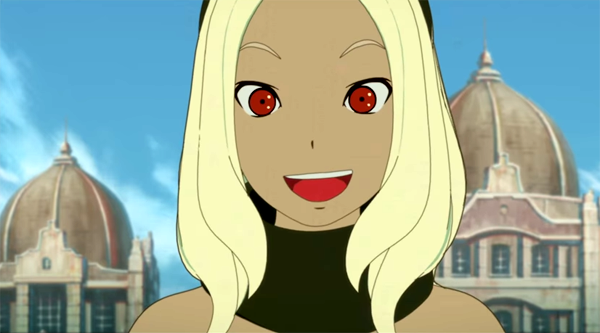Gravity Rush 2 is little under a month away, and I prefer to pretend it’s already here. I’m running a
Gravity Rush contest for a few more days, and I’m busy playing the demo that went up on the PlayStation Network last week. And just today, Sony released the two-part
Gravity Rush: The Animation – Overture. Sure, you can watch it for free on Sony’s
YouTube Channel, but why do that when instead you can read my opinion of it?
Or maybe I'll just use a picture.

A bridge between the first game and the sequel,
Overture answers at least one important question about Gravity Rush: what do the characters like to eat?
Yes, it goes all of two minutes before trotting out a harmless but tiresome cliché: the heroine flying into a violent fury when a precious, newly acquired snack is destroyed. Floating around a market, Kat buys a kabob, loses it, and trashes bug-eyed Nevi shadow creatures, whereupon Raven, her less cheerful rival, shows up and lends a hand. This occupies half of
Overture’s running time.
The second half jumps back a short while and finds Kat and Raven eating snacks (of course) and discussing a recent spate of disappearances in their home city of Hekseville. They’re suddenly sent to a mysterious floating island where a HAL-like computer holds children hostage in little power cels. Two half-masked, mummy-like antagonists appear, and then everyone ends up warped to the strange new city we’ll see in Gravity Rush 2.
Overture is an enjoyable gap-filler, all things considered. I can't imagine it swaying those with no interest whatsoever in Gravity Rush, but it brings up the game's best points. The animation is vibrant and mostly fluid, capturing the details of the floating city and Kat’s bubbly personality—which fortunately develops beyond “I like to eat” in the second half. It also keeps the fictional language from the games, as the characters all use the same melodious semi-French, semi-Japanese tone (in which Kat and Raven’s names sound the same as they do in English). I’m a sucker for made-up languages. I’d watch Barb Wire if everyone talked like they were speaking Italian and Swahili backwards.
Short as it is,
Overture stokes my
Gravity Rush 2 interest, which was, of course, crazily high already. I’m gonna go play the demo another dozen times.



